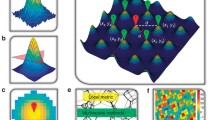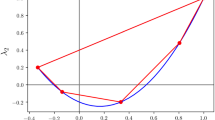Abstract
Texture is the orientation distribution of crystallites in polycrystalline materials. Given the discrete orientations, Schaeben suggested to adopt statistics for quantitative analysis of texture from discrete orientations, and he also conceived a clustering algorithm to facilitate the applications of statistical methods (H. Schaeben, J Appl Crystal 26:112–121, 1993). This data-driven scheme becomes more urgent and more necessary for the oncoming fourth paradigm: data-intensive scientific discovery, which follows after experimental science, theoretical science, and computational science paradigm. This research adopts a density-based clustering algorithm, DBSCAN, to process the orientation data from an austenitic stainless steel 316 L sample fabricated by selective laser melting. It is validated that the algorithm can robustly identify the orientation cluster (or texture component or preferred orientation). The statistical methods can successfully quantify the features of the identified orientation cluster with quantified uncertainty (statistical significance), which is often lacked in the general method of orientation distribution function. It is believed that this data-driven scheme can be applied to the many aspects of texture analysis.







Similar content being viewed by others
References
U.F. Kocks, C.N. Tomé, H.-R. Wenk, and A.J. Beaudoin: Texture and Anisotropy: Preferred Orientations in Polycrystals and Their Effect on Materials Properties. (Cambridge University Press, Cambridge, 2000).
Hans-Joachim Bunge, Zeitschrift fur metallkunde 1965, vol. 56, pp. 872-&.
Ryong‐Joon Roe, Journal of Applied Physics 1965, vol. 36, pp. 2024-2031.
Adnan Eghtesad, Timothy J. Barrett and Marko Knezevic, Acta Materialia 2018, vol. 155, pp. 418-432.
Stephen R. Niezgoda and Jared Glover, Metallurgical and Materials Transactions A 2013, vol. 44, pp. 4891-4905.
J. K. Mason and C. A. Schuh, Metallurgical and Materials Transactions A 2009, vol. 40, p. 2590.
Ralf Hielscher, Journal of Multivariate Analysis 2013, vol. 119, pp. 119-143.
H. Schaeben, Journal of Applied Crystallography 1993, vol. 26, pp. 112-121.
Katja Jochen and Thomas Bohlke, Journal of Applied Crystallography 2013, vol. 46, pp. 960-971.
N.C.K. Lassen, D.J. Jensen, and K. Conradsen: Acta Crystallogr. Sect. A 1994, vol. 50, pp. 741–48.
K.V. Mardia and P.E. Jupp: Directional Statistics. (Chichester, John Wiley & Sons, 2009).
Joshua R. Davis and Sarah J. Titus, Journal of Structural Geology 2017, vol. 96, pp. 65-89.
Aleksandr Chernatynskiy, Simon R. Phillpot and Richard LeSar, Annual Review of Materials Research 2013, vol. 43, pp. 157-182.
I. Koch: Analysis of Multivariate and High-Dimensional data. (New York, Cambridge University Press, 2013).
K. Gerald van den Boogaart, Materials Science Forum 2005, vol. 495-497, pp. 179-184.
M. Ester, H.-P. Kriegel, J. Sander, and X. Xu: in: Proceedings of the Second International Conference on Knowledge Discovery and Data Mining (KDD’96), 1996, pp. 226–31.
Anil K. Jain, Pattern Recognition Letters 2010, vol. 31, pp. 651-666.
Anthony JG Hey, Stewart Tansley and Kristin M Tolle: The fourth paradigm: data-intensive scientific discovery. (Microsoft research Redmond, WA, 2009).
Adam J. Schwartz, Mukul Kumar, Brent L. Adams and David P. Field: Electron backscatter diffraction in materials science. (2014).
Henning Poulsen, Journal of Applied Crystallography 2012, vol. 45, pp. 1084-1097.
Ashley A. White, MRS Bulletin 2013, vol. 38, pp. 594-595.
J. Han, J. Pei, and M. Kamber: Data Mining: Concepts and Techniques, Elsevier, New York, 2011.
Erich Schubert, Jörg Sander, Martin Ester, Hans Peter Kriegel and Xiaowei Xu, ACM Trans. Database Syst. 2017, vol. 42, pp. 1-21.
Fabian Pedregosa, Gaël Varoquaux, Alexandre Gramfort, Vincent Michel, Bertrand Thirion, Olivier Grisel, Mathieu Blondel, Peter Prettenhofer, Ron Weiss and Vincent Dubourg, Journal of machine learning research 2011, vol. 12, pp. 2825-2830.
R.J.G.B. Campello, D. Moulavi, and J. Sander: in Advances in Knowledge Discovery and Data Mining, J. Pei, V.S. Tseng, L. Cao, H. Motoda, and G. Xu, eds., Springer, Berlin, 2013, pp. 160–72.
H.-J. Bunge: Texture Analysis in Materials Science: Mathematical Methods, Elsevier, Cambridge, 2013.
M. Humbert, N. Gey, J. Muller and C. Esling, Journal of Applied Crystallography 1996, vol. 29, pp. 662-666.
Jean Christophe Glez and Julian Driver, Journal of Applied Crystallography 2001, vol. 34, pp. 280-288.
R. Quey, J. H. Driver and P. R. Dawson, Journal of the Mechanics and Physics of Solids 2015, vol. 84, pp. 506-27.
Florian Bachmann, Ralf Hielscher, Peter E. Jupp, Wolfgang Pantleon, Helmut Schaeben and Elias Wegert, Journal of Applied Crystallography 2010, vol. 43, pp. 1338-1355.
Stine Krog-Pedersen, Jacob R. Bowen and Wolfgang Pantleon, International Journal of Materials Research 2009, vol. 100, pp. 433-438.
W. Pantleon, Materials Science and Technology 2005, vol. 21, pp. 1392-1396.
D. C. Handscomb, Canadian Journal of Mathematics 1958, vol. 10, pp. 85-88.
J. K. Mackenzie, Biometrika 1958, vol. 45, pp. 229-240.
Maria Halkidi, Yannis Batistakis and Michalis Vazirgiannis, Journal of Intelligent Information Systems 2001, vol. 17, pp. 107-145.
Olivier Andreau, Imade Koutiri, Patrice Peyre, Jean-Daniel Penot, Nicolas Saintier, Etienne Pessard, Thibaut De Terris, Corinne Dupuy and Thierry Baudin, Journal of Materials Processing Technology 2019, vol. 264, pp. 21-31.
David T. Fullwood, Stephen R. Niezgoda, Brent L. Adams and Surya R. Kalidindi, Progress in Materials Science 2010, vol. 55, pp. 477-562.
Tilman Lange, Volker Roth, Mikio L. Braun and Joachim M. Buhmann, Neural Computation 2004, vol. 16, pp. 1299-1323.
O. Shamir and N. Tishby: Cluster Stability for Finite Samples, MIT Press, Cambridge, 2008.
Stuart I. Wright, Matthew M. Nowell and John F. Bingert, Metallurgical and Materials Transactions A 2007, vol. 38, pp. 1845-1855.
A. Gunawan: Master’s Thesis, Eindhoven University of Technology, The Netherlands, 2013.
Acknowledgments
This research was funded by the Joint Funds of the National Natural Science Foundation of China under Grant U1605243.
Author information
Authors and Affiliations
Corresponding authors
Additional information
Publisher's Note
Springer Nature remains neutral with regard to jurisdictional claims in published maps and institutional affiliations.
Manuscript submitted June 9, 2019.
Rights and permissions
About this article
Cite this article
Wang, Y., Yu, C., Xing, L. et al. A Data-Driven Scheme for Quantitative Analysis of Texture. Metall Mater Trans A 51, 940–950 (2020). https://doi.org/10.1007/s11661-019-05529-x
Received:
Published:
Issue Date:
DOI: https://doi.org/10.1007/s11661-019-05529-x





